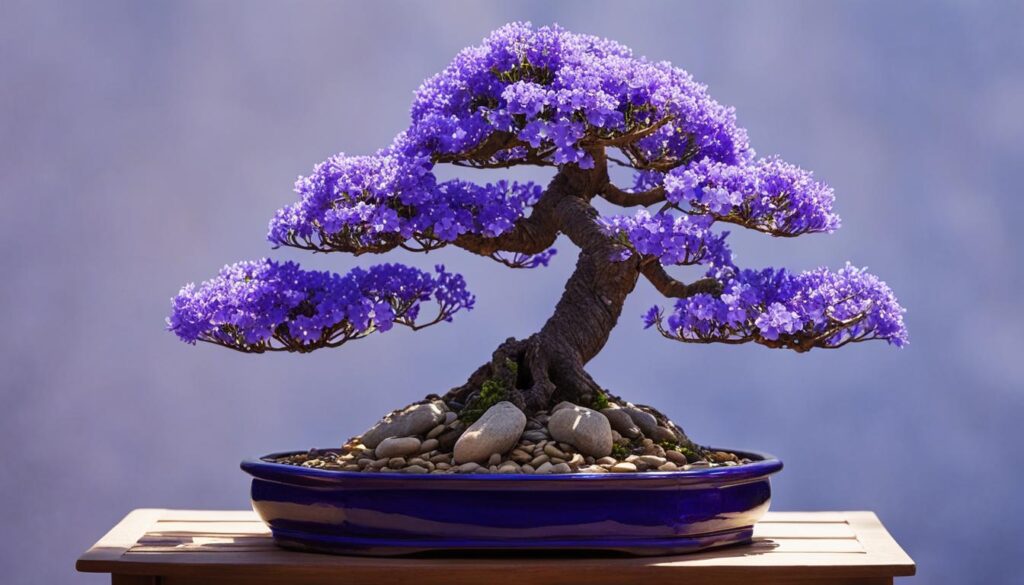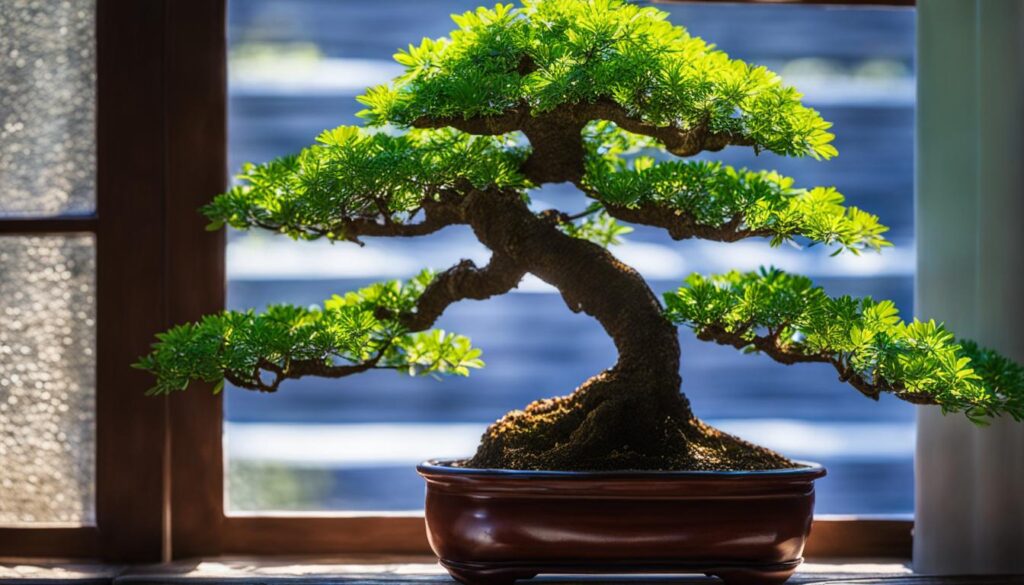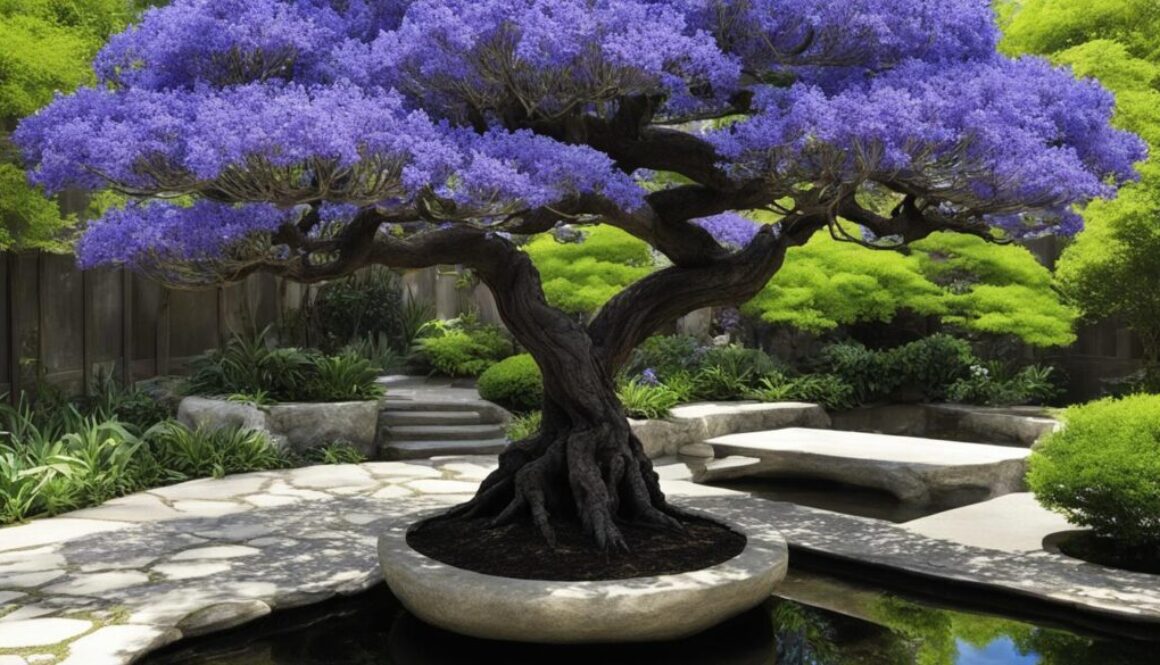Bonsai Blue Jacaranda Growing and Care Guide
If you’re looking to add a touch of elegance and exoticism to your bonsai collection, the Blue Jacaranda tree is a stunning choice. With its vibrant blue or purple flowers and unique fern-like leaves, this bonsai variety is sure to captivate your heart.
Discover the secrets to successfully growing and nurturing the Blue Jacaranda bonsai. From understanding its origins and uniqueness to providing proper placement, watering practices, soil and fertilizing needs, pruning and wiring techniques, repotting guidelines, and dealing with pests, this guide has got you covered.
Let’s dive in and explore the world of Blue Jacaranda bonsai together!
Do jacaranda make good bonsai?

Jacaranda trees, including the Bonsai Blue Jacaranda, have become increasingly popular among bonsai enthusiasts due to their stunning foliage and vibrant purple flowers. With proper care and cultivation techniques, jacaranda can make excellent bonsai trees. They are known for their unique fern-like leaves and beautiful blue or purple flowers, which add an aesthetic appeal to any bonsai collection. However, caring for a jacaranda bonsai requires specific knowledge and practices to ensure its health and growth. In this guide, we will delve into the details of caring for a Bonsai Blue Jacaranda, covering all the essential aspects of bonsai care to help you decide if this variety is right for you.
An Introduction to Bonsai Blue Jacaranda

The Blue Jacaranda Bonsai, scientifically known as Jacaranda mimosifolia, is a semi-evergreen tree native to South America. This unique and elegant tree has captured the hearts of bonsai enthusiasts with its delicate fern-like foliage and stunning blue or purple flowers. One particular variety that stands out is the ‘Bonsai Blue’, a dwarf bonsai blue jacaranda that is highly sought after for its compact size and manageable height.
Origins and Uniqueness of Blue Jacaranda Bonsai
The jacaranda mimosifolia, also known as the Blue Jacaranda, has its roots in South America. It boasts a distinctive appearance with its intricate, fern-like leaves and vibrant blue or purple flowers. The uniqueness of the Blue Jacaranda Bonsai lies in its ability to replicate the beauty of a full-sized jacaranda tree in a miniature form, making it an excellent choice for bonsai enthusiasts.
Understanding the Dwarf Variety: ‘Bonsai Blue’
The ‘Bonsai Blue’ is a sought-after variety of the Blue Jacaranda Bonsai. It is known for its compact size and manageable height, making it easier to care for and perfect for smaller spaces. The dwarf bonsai blue jacaranda has all the unique features of its larger counterparts, including the fern-like foliage and stunning blue or purple flowers. Its smaller stature makes it an ideal choice for bonsai enthusiasts looking for a more manageable tree to cultivate and showcase.
Why Blue Jacaranda Bonsai Captures Enthusiasts’ Hearts
The Blue Jacaranda Bonsai captures the hearts of bonsai enthusiasts for several reasons. Firstly, its delicate and intricate fern-like foliage adds a touch of elegance to any bonsai collection. Secondly, the stunning blue or purple flowers create a captivating display when in bloom, making it a focal point of admiration. Lastly, the ability to cultivate a miniature version of a majestic and exotic tree like the jacaranda mimosifolia brings a sense of awe and accomplishment, making it a cherished addition to any bonsai enthusiast’s collection.
Average height of Jacaranda Bonsai
The average height of a Jacaranda Bonsai can vary depending on the specific variety and growing conditions. While the full-sized jacaranda tree can reach heights of up to 15 meters, the bonsai version typically ranges from 1.5 meters to a few feet tall. The compact size of the bonsai blue jacaranda allows for easier cultivation and maintenance, making it a popular choice among bonsai enthusiasts.
Proper Placement for Your Blue Jacaranda Bonsai Tree

The proper placement of your Blue Jacaranda Bonsai tree is essential for its growth and overall development. To ensure the health and vitality of your bonsai, it is crucial to consider the light and temperature requirements specific to this variety.
The Blue Jacaranda Bonsai thrives in well-lit environments and requires a significant amount of light to support its optimal growth. It is best to place your bonsai in a sunny spot or semi-shade, depending on the specific variety. This will ensure that the tree receives the necessary amount of light for photosynthesis and overall health.
When considering placement, it is important to protect your Blue Jacaranda Bonsai from temperatures below 15°C (59°F). Extreme cold can be detrimental to the tree’s health, so it is crucial to avoid exposing it to freezing temperatures. Additionally, it is advisable to keep the bonsai away from direct hot air, such as that emanating from heating devices, as it can cause damage.
In warmer climates, where the temperatures remain consistently above 15°C (59°F), you can place your Blue Jacaranda Bonsai outside. A sunny location with sufficient airflow and ventilation will provide the ideal environment for the tree to flourish. Remember to regularly monitor the temperature, especially during colder nights or sudden drops in temperature.
Optimal Watering Practices for Bonsai Blue Jacaranda
When it comes to caring for your Bonsai Blue Jacaranda, proper watering is crucial for maintaining its health and vitality. By following optimal watering practices, you can ensure that your bonsai tree thrives and displays its stunning blue and purple flowers.
To keep your Blue Jacaranda bonsai in its best condition, it is essential to keep the root ball slightly moist. However, be careful not to overwater or let the roots dry out, as both can cause harm to the tree.
Regularly monitoring the moisture levels of the soil is key to determining the watering needs of your bonsai. You can test the moisture level by gently poking your finger into the soil up to your first knuckle. If it feels moist, you can hold off on watering. If it feels dry, it’s time to water the tree.
However, it’s important to recognize that watering frequency can vary based on factors such as the temperature, humidity, and the specific needs of your Blue Jacaranda Bonsai. As a general guideline, bonsai trees typically require watering every 2-3 days, but this may need to be adjusted based on your specific growing conditions.
Here are some expert tips to help you maintain optimal watering practices for your Bonsai Blue Jacaranda:
- Use a watering can or a gentle spray nozzle to water your bonsai tree to avoid disturbing the delicate roots.
- Water the tree thoroughly, allowing the water to penetrate the entire root system.
- Avoid leaving stagnant water in the saucer or tray, as this can lead to root rot.
- During hot summer months or in dry indoor environments, consider misting the foliage regularly to create a humid microclimate.
Remember, proper watering is a balancing act. Be attentive to the moisture levels in the soil and adjust your watering frequency accordingly. With consistent care, your Bonsai Blue Jacaranda will reward you with its beautiful blooms and lush foliage.
For a visual representation of the optimal watering practices for Bonsai Blue Jacaranda, refer to the table below:
The Importance of Soil and Fertilizing for Jacaranda mimosifolia Bonsai

The soil composition and fertilization of your Blue Jacaranda Bonsai play a crucial role in its overall health and growth. A well-draining soil mix that provides proper nutrient availability is essential for the development of a thriving bonsai tree.
When it comes to blue jacaranda soil, it is important to create a well-draining mixture that promotes healthy root growth. A bonsai tree soil mix specifically formulated for jacaranda bonsai is ideal. This mix should consist of a combination of organic and inorganic materials, such as organic potting soil, perlite, and crushed granite. The organic potting soil provides the necessary nutrients, while the perlite and crushed granite ensure proper drainage and aeration.
Soil drainage is particularly important for blue jacaranda bonsai as they prefer slightly acidic to neutral soil pH levels. Poor drainage can lead to root rot and other soil-related issues. Therefore, it is crucial to select a soil mixture that allows excess water to flow freely, preventing waterlogging.
When it comes to fertilizing your jacaranda bonsai, using a balanced liquid fertilizer during the growing season is recommended. This type of fertilizer provides essential nutrients and trace elements that promote healthy growth and flowering. It is important to follow the instructions on the fertilizer packaging and avoid over-fertilization, as it can cause root burn and other adverse effects.
Furthermore, it is advisable to apply a slow-release fertilizer in spring to provide a steady supply of nutrients over an extended period. This helps support the long-term health and vitality of your blue jacaranda bonsai.
| Soil Composition | Benefits |
|---|---|
| Organic potting soil | Provides essential nutrients |
| Perlite | Improves drainage |
| Crushed granite | Enhances aeration |
By ensuring the proper soil composition and providing adequate fertilization, you can create an optimal growing environment for your Blue Jacaranda Bonsai. This will support its overall health, growth, and stunning displays of vibrant blooms.
Pruning and Wiring Your Jacaranda Plant
Pruning and wiring techniques are essential for shaping and maintaining the desired form of your Blue Jacaranda Bonsai. Regular pruning helps control the growth of the tree and encourages branching, while wiring allows you to bend and guide the branches into the desired shape.
To prune your Jacaranda Bonsai, start by identifying any undesirable or overgrown branches. Using clean and sharp bonsai shears, make precise cuts just above a leaf node or bud to encourage new growth in the desired direction. It’s important to remove any dead, damaged, or crossing branches to maintain the overall health and aesthetics of your bonsai tree.
When wiring your Jacaranda Bonsai, choose flexible bonsai wire that is appropriate for the thickness of the branches. Gently wrap the wire around the branch, starting from the base and working your way up. Be careful not to wrap the wire too tightly, as it can damage the branch. Once the wire is in place, gently shape the branch by bending it in the desired direction. The wire should remain in place for several months or until the branch has hardened into the desired shape. Remember to regularly check the wire to ensure it is not cutting into the branch or causing any harm.
Both pruning and wiring should be done with care and precision to avoid stressing or injuring your Jacaranda Bonsai. It’s important to understand the growth patterns and natural form of the tree, and to make adjustments accordingly to achieve the desired shape and aesthetics.
When and How to Repot Jacaranda mimosifolia

Repotting is an essential aspect of bonsai tree care, including the Blue Jacaranda Bonsai. It allows for the refreshment of the soil, root pruning, and root repositioning, promoting the overall health and vitality of the tree.
To determine the ideal repotting schedule for your Blue Jacaranda Bonsai, consider the following factors:
- Growth rate: Repot younger trees every 1-2 years to encourage development. Mature trees may only need repotting every 3-5 years.
- Root system: Inspect the root ball by gently removing the tree from its pot. If you notice a dense root system circling the pot, it’s time to repot.
- Season: Repot during the spring or early summer when the tree is actively growing and can recover quickly.
When repotting your Blue Jacaranda Bonsai, follow these step-by-step instructions:
- Choose a slightly larger pot with good drainage to accommodate the tree’s root system.
- Prepare the new pot by adding a layer of bonsai soil mix to the bottom.
- Gently remove the tree from its current pot, taking care not to damage the roots.
- Trim the roots to promote new growth and maintain a balanced root-to-foliage ratio.
- Position the tree in the new pot, ensuring the root system is spread evenly.
- Add bonsai soil mix around the roots, gently firming it to eliminate air pockets.
- Water the tree thoroughly, allowing the excess water to drain out.
- Place the repotted Blue Jacaranda Bonsai in a shaded area for a few weeks to aid in recovery.
By following these repotting instructions along with using an appropriate soil mix for repotting, you can promote the growth and longevity of your Blue Jacaranda Bonsai.
Blue Jacaranda: Dealing with Pests and Ensuring Healthy Blooms
As a bonsai enthusiast, you know that maintaining the health and beauty of your Blue Jacaranda Bonsai is crucial. Just like any other plant, this unique tree is susceptible to pests and diseases that can hinder its growth and flowering. By being aware of common pests and taking proactive measures for pest control, you can ensure healthy blooms and vibrant foliage that will captivate any viewer.
Some common pests that can infest your Jacaranda Bonsai include aphids, whiteflies, and mealybugs. These tiny insects can cause leaf damage, sap depletion, and hinder proper growth. To combat these pests, you can use organic pest control methods such as insecticidal soap or neem oil. Regularly inspect your bonsai tree and treat any infestations promptly to prevent further damage.
In addition to pest control, ensuring healthy blooms on your Blue Jacaranda Bonsai requires proper care and attention. Adequate sunlight, proper watering, and nutrient-rich soil are essential. Provide your tree with sufficient sunlight for at least 6 hours a day, making sure it receives the right amount of light without scorching its delicate leaves.
Furthermore, water your bonsai tree carefully, avoiding overwatering or letting the soil dry out completely. Keep a close eye on the moisture levels, adjusting your watering frequency accordingly. Lastly, use a well-draining soil mix and fertilize your Jacaranda Bonsai during the active growth period to provide the necessary nutrients. With these practices in place, your Blue Jacaranda Bonsai will thrive and reward you with stunning blooms.

Karen Phillips, Bonsai expert and blogger. Read more about me here


